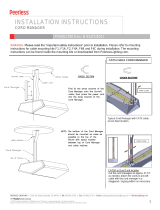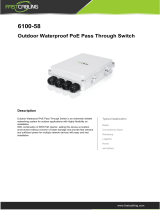
6
Before You Begin
Get to Know the Access Point Features
Table 1. LEDs and connectors on the AP
Label Description
Power LED
•Off: No power is available, or the AP is not connected to a power
source.
•Red: The AP is powering on.
• Green: The AP is connected to a power source and has
completed its power-on sequence.
Status LED If the AP is operating in standalone mode:
• Amber: The WLAN service is up and at least one wireless client
is associated with the AP.
• Flashing amber: The WLAN service is up and no wireless clients
are currently associated with the AP.
If the AP is being managed by Ruckus Wireless ZoneDirector:
• Green: The AP is part of a mesh network (either as Root AP or
Mesh AP) and is connected to an uplink with good signal. If mesh
networking is disabled but the WLAN service is available, the
Status LED is also green.
• Fast flashing green: The AP is part of a mesh network (as Mesh
AP) and is connected to an uplink with fair signal.
• Slow flashing green: This Mesh AP is searching for an uplink or
is attempting to establish communication with ZoneDirector.
• Off: Mesh networking is disabled and the WLAN service is
unavailable.
RJ45 Connectors Two LAN ports that support Power over Ethernet (PoE):
• PoE IN port: Supports 10/100/1000Mbps connections, connects
to the network and receives 802.at PoE from the Ruckus Wireless
60W PoE injector (not supplied, may be ordered separately –
part number 902-0180-XX00, where XX is the country code).
• PoE OUT port: Supports 10/100Mbps connections. If the AP is
using AC power or the Ruckus Wireless PoE injector (ordered
separately), this port can supply 802.af PoE to the connected
PoE-capable device (for example, another ZoneFlex 7762 AC AP
or an IP-based surveillance camera). To use this port to supply
PoE, you first need to enable the PoE feature on the Web
interface. If you use PoE only to power the AP and you want to
use the PoE OUT port to supply power to another device, you
must use the Ruckus Wireless 60W PoE injector (part number
902-0180-XX00, where XX is the country code), which may be
ordered separately.
AC Power Connector You can use AC to supply power to the AP, in addition to using PoE.

























